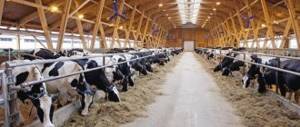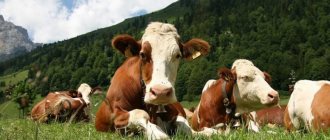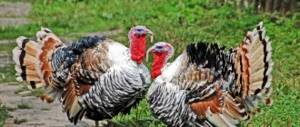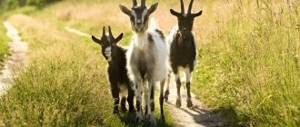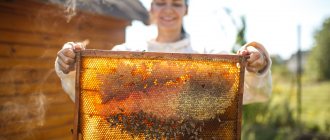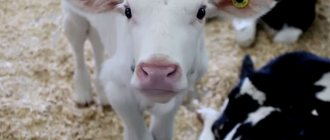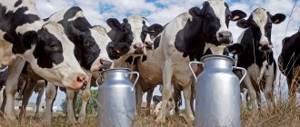Enterprise profitability
So, if you find yourself on this page, it means you are interested in goat breeding. Why does this area have such high profitability?
1. Goat milk. The first thing we will talk about, of course, is the final product, for which, in fact, the whole goat business is started. Since the meat of these animals is specific and is consumed only by gourmets and residents of rural areas, it cannot be considered a suitable food product. But goat's milk - just like that.
The milk secreted by a goat, despite the fact that, like cow’s milk, cannot be completely absorbed by people due to the peculiarities of the human body, nevertheless, it has many advantages over cow’s milk, for which it is intensively used in various areas of human activity. Yes, it is:
- rich in microelements such as iron, selenium, zinc;
- has less fat content;
- significantly less likely to cause allergies to milk protein;
- suitable for use by people who are lactose intolerant, since the concentration of milk sugar in it is much lower;
- highly nutritious.
Goat milk has a fine and delicate texture
Goat milk is today widely used in the following areas:
- production of baby food;
- cosmetic procedures;
- creating skincare cosmetics;
- dietetics;
- medicine;
- Food Industry;
- other various areas of activity.
If you choose the right breed of goats, milk yield can reach record levels.
Prices for milking machines for goats
Goat milking machine
2. Little competition. Due to the combination of many different factors, today you will not have many competitors in the goat farming business niche.
On an industrial scale, this type of animal is practically not used, therefore, by having cows, you become competitors with huge agricultural cartels and private farms, but by purchasing goats and breeding them, you have at most several similar or smaller farms as competitors.
There is little competition in the goat business
3. By-products. Despite the fact that goat meat, as we have already said, has a rather specific taste, nevertheless, it can also be obtained from these amazing animals. In addition, they also provide wool. Provided that you find a niche for selling one of the products listed in this column, you can also make good money on them.
Goat meat is a valuable food product
If you are going to make money selling meat, you need to know how to cut up a goat carcass. Read about this in a special article.
4. Easy to care and maintain. Goats, unlike the same cows, with fairly large production volumes, are very unpretentious in care and maintenance. So, in order to breed them, compared to cattle, you need:
- have much smaller areas;
- have a small start-up capital;
- spend much less money on raising young animals;
- spend less money, time, and labor on caring for animals, etc.
Goats are easy to keep
The smaller size of goats reduces both initial and subsequent costs, while the opportunity to make money on goats is just as great as on cows or in other areas of agricultural activity.
5. Possibility of selling young animals. Selling young animals is another very profitable financial branch of this business, that is, your potential source of profit. One goat can give birth to several kids at a time, which you will only need to grow a little, and then, if there is an excess of them, sell them to those who wish, for example:
- to private farms;
- to local farms;
- even to farms in other cities, etc.
As soon as you yourself have enough animals, you can start making money by providing them to the surrounding lands, even neighboring regions.
Newborn goats
Depending on how rare the breed you will breed, the price of kids can vary significantly:
- Thus, a simple kid of the “Russian White” breed can be sold at a cost of one and a half thousand rubles;
- kids of the Anglo-Nubian can be bought from you for as little as 7-10 thousand rubles.
Of course, the better the health of the offspring, the higher the price, so care for the kids and their mother must be appropriate.
6. No need for specific education. Of course, as in any other case, it will be better if goat breeding is your professional specialty initially, or that you at least have a general understanding of how goats are raised.
Provided that you have neither this nor that, you can acquire knowledge:
- by attending lectures on livestock farming in agricultural educational institutions;
- stock up on a pile of literature and read it from cover to cover;
- get advice from knowledgeable people.
The profitability of the goat fishery is quite high
In any case, in the absence of specific knowledge, you will first have to learn, and only then you can start raising goats. However, you will not need money to obtain this education, since knowledge in this case can be obtained independently, by studying sources of various information on the topic, and then empirically.
As you can see, there are a decent number of positive aspects of the goat farming business that literally doom this business to success. Our task with you is to further in the article competently determine what our steps will be on the path to opening our own business in the area of interest.
Do I need to register a business?
Also check out these articles
- Schefflera - care and reproduction
- Indoor Jasmine flower
- Tomato variety Pink Elephant
- Red Baron onion variety
Small goat breeding business is rarely registered, since it is impossible to get a big profit from it, and the sales are local. If the production is large, you need to obtain certificates and licenses, and also register as an individual enterprise. This is a very troublesome task and not cheap. So you need to be patient.
If the production is large, you need to obtain certificates and licenses
It’s worth noting right away that not only in different countries, but even in different cities, the procedure for obtaining a business permit may be different. So no one can give exact instructions on this matter. But after receiving all the necessary papers, you can start raising goats as a business and make a significant profit from it.
Registering a company
Our next step will be to register the business we plan to engage in, since each entrepreneurial activity is subject to the law by officially declaring itself as such.
How to register a business?
In our case, it would be best to focus on a more profitable form of entrepreneurship - “IP”, since it implies much lower tax deductions than “LLC”. However, you should understand that all responsibility, in the event of any troubles, will fall on your shoulders.
When registering a business activity, you will be required to submit activity codes to the relevant authorities. In your case, the number sequences will need to correspond to the following areas of entrepreneurship:
- goat breeding;
- sales of dairy products.
To engage in goat farming for profit, you need to become an individual entrepreneur
During the process of registering an enterprise, you will be assigned a personal state number and given a OGRN certificate confirming this fact.
Now that you have become an individual entrepreneur, you need to go through a few more important events:
- submit an application to the administration of your settlement to lease or purchase land for agricultural purposes;
- obtain permission to farm, and at the same time sell the dairy products you produce directly from the Rospotrebnadzor Office of the region in which you live;
- obtain permission from the fire inspectorate, as well as the environmental inspectorate, to use the farm premises you have chosen;
- register ownership of land and premises, if you do not already have them.
The listed procedures can only be carried out if you have all the necessary documents in your hands.
Official formalities are necessary so that you can conduct your business legally
You can collect them yourself, but this is not a quick task, therefore, it is best to contact an experienced lawyer and find out from him:
- list of documents you need;
- where to get each paper;
- where to send the collected documents.
This way, you can reduce the time spent on organizing your business.
We draw up a business plan
To understand where to start and where to go, it is best to start by drawing up a so-called business plan, with the help of which the main points of our future enterprise will be determined.
Business plan cover design
Most often, a business plan is used to convince potential borrowers that you plan to open a profitable business and will be able to pay them back the money you borrowed or justify a government subsidy. So, the following organizations can sponsor your business:
- friendly individual entrepreneurs;
- banks;
- employment centers;
- small business support centers, etc.
So, let's start compiling.
Step #1 – compose an executive summary
An executive summary is a brief overview of our future business plan, where we outline project details such as:
- the goal of the entire enterprise: in our case it will be the production of goat milk on the basis of a personal farm;
- total cost of the project: here you will indicate the amount of your starting capital, and you will need to indicate whether you are using only personal funds, or funds from borrowers (for example, a bank);
- business address: indicate the address where the actual activities of your farm will be carried out.
Execution of an executive resume
Well, it seems it's not that complicated. Let's move on to the second, more capacious segment of the plan.
Step No. 2 - everything about the product being manufactured
Do not forget that you are planning to start the entire enterprise in order to produce goat milk. This aspect must be indicated in the second step, as well as the stages of activity to obtain the final product that you plan to implement. So, for example, to sell goat milk you will need to go through the following steps.
1. The first stage will be to acquire a source of production - lambs or adult breeding goats. You determine the number of animals yourself, but we recommend that you stop at 2-4 individuals to begin with.
2. The second stage is essentially represented by caring for purchased animals, that is, raising them and in the process:
- feeding;
- content;
- grazing;
- washing, etc.
There is no need to reveal the second point so carefully. However, in itself it does exist, so it must be mentioned.
3. The third stage is the receipt and sale of products that interest us. How and to whom you will sell the milk does not need to be written in detail at this stage.
Item "about the product"
Step No. 3 - draw up a production plan
Production plan - brief description:
- all production nuances;
- work carried out related to your business.
Production plan
Here it will be necessary to describe in more detail how the production and sale of goods occurs, touching on all important aspects. In your case, this plan will look something like this.
- The first step is to purchase goat kids in an amount from 2 to 4 (the number of individuals you previously determined, you need to enter one exact number) for an amount equal to, for example, 35 thousand rubles.
- Purchase of feed for young goats for an amount equal to 12 thousand rubles.
- Repair of the barn at the farmer's disposal, in the amount of 8.5 thousand rubles.
- Construction of additional stalls in the amount of 6 thousand rubles.
- Contributions to the Pension Fund of the Russian Federation in the amount of 8 thousand rubles.
- Expenses for transporting animals in the amount of 3 thousand rubles.
- It is planned to receive milk from purchased goats after the first mating of the animal (which, according to agricultural standards, should be done no earlier than the animal reaches one and a half years old). Depending on how old the kids you purchased are, you must indicate a specific number, for example, after 12 months.
- Next, list your sales revenue. So, for example, you plan to implement:
- 700 liters of milk;
- at a price of 100 rubles per liter.
Therefore, your total annual revenue should be 70 thousand rubles.
Raising goats, unfortunately, involves paperwork
Step No. 4 - draw up a marketing plan
At this step, you need to decide exactly how the products will be sold, that is:
- will you sell milk directly to the local population;
- will you go to the market?
- will you sell milk as a farmer-supplier to various city shops, etc.
It is also necessary to indicate what the price of one liter of product will be, we have already decided that for us it is 100 rubles, as well as what is the planned volume of goods (we have 700 liters) and, accordingly, the planned revenue (we have 70 thousand rubles).
Proper execution of a marketing plan
Step No. 5 - draw up an organizational plan
The organizational plan essentially describes who will take part in your enterprise, taking into account not only the direct workers on the labor front, but also those taking part in the financial support of this event.
Correct design of the organizational plan
1. So, first of all, it is necessary to indicate in what form the activities of the enterprise are registered. As we have already said, we will operate as an individual entrepreneur, registered:
- in the role of a peasant farm;
- as a private form of ownership.
2. It is also necessary to indicate the last name, first name and patronymic of the citizen or citizen who is the owner of the business, for example, Margarita Semyonovna Kireeva.
In this section, you need to mention the amount of funds invested in the enterprise, both your own and those received from someone else.
3. Next, we indicate whether we plan to involve hired labor, that is, third-party assistants.
4. The next step is to indicate the total cost of the project and again divide it into separate amounts:
- your personal investment in the business;
- funds from borrowers, subsidies from the state, etc., if any.
Having completed the fifth step, we will proceed to the last and at the same time the most difficult stage of drawing up a plan.
Step No. 6 - draw up a financial plan
You will be able to draw up a financial plan only after you have acquired the status of an official representative of the self-employed category of the population - an individual entrepreneur - from the tax service.
An example of compiling a table “Forecast of income and expenses”
So, in this section you will need to indicate the following.
1. What type of tax will your income be subject to? Since we will be engaged in business directly related to the production and sale of agricultural products, we have the right to switch to a specialized taxation regime and begin to be subject to a single agricultural tax, which is why we indicate it.
2. Next, you need to indicate the rate of the tax system at which our organization operates. Thus, for 2018 the rate for the unified agricultural tax is 6%. However, provided that you are going to open a goat milk production business in the Republic of Crimea, then “lighter” conditions will apply to you, that is, the rate will drop as much as 4%. Be careful and indicate the current rate for you.
3. You must also indicate the object of taxation. In the case of the unified agricultural tax, the object of taxation is the income of your enterprise, which was reduced by the amount of expenses you incurred.
An example of compiling a table “Forecast of cash flows”
4. Now you need to indicate how you will pay pension contributions to the state treasury. So, according to the letter of the law, the owner of peasant farms independently transfers funds to the Pension Fund:
- for myself;
- for all members of the household.
At the same time, payments are in the nature of fixed payments.
In addition, payments are also supposed to be transferred to the Federal Compulsory Health Insurance Fund.
So, in 2021 these payments will have the following value:
- Pension Fund of the Russian Federation - 26 thousand 545 rubles;
- FFMS - 5 thousand 840 rubles.
Believe me, all the effort you put into drawing up a business plan will pay off many times over.
5. Next you will need to create two tables. You can see an example of their compilation in the pictures located in this step. Let's take a look at what nuances need to be written down in each of them.
Table 2. Contents of financial plan calculations
| Income and Expense Plan | Cash flow plan |
|
|
A business plan can be used by both experienced entrepreneurs and novice businessmen
As you can see, it turned out to be not so difficult to compile it. Now that you have this document in your hands, you need to either keep it and stick to your plan, or submit it for consideration to potential lenders or organizations that provide you with support in the form of a subsidy.
Goat housing
Before keeping domestic goats, you will need to make a stall. Every little detail is important in the construction because it will help in raising healthy goats.
Goathouse for goats
Placement and equipment of the goat house
The building is placed in a dry, open, slightly elevated place. Loud noises can frighten goats, for this reason the place must be calm. To avoid drafts, install windows and doors on every second square meter of the barn, at a height of about one and a half meters from the ground. Doors are installed so that they open outward. An integral component of the barn is the installation of a threshold with a height of 14-16 cm, so that humus does not fall out onto the street.
Stone barn
Don't forget to install a hood indoors. To further saturate the room with fresh oxygen, holes are drilled from below, and to get rid of fumes, square pipes are installed on top. For 10 goats, make one hood with an area of 35 by 35 cm, with a height of 4.5-6 m.
Features of the room and stall
The room can be stone, wood or brick. A hoist or roofing material is placed on top of the stone or brick material to prevent dampness from appearing inside the room. The floor is most often made of concrete, since wood is noticeably more expensive. Due to the fact that the goat sleeps in a horizontal position, small shelves 60 cm wide are placed on the sides, at a height of 30-40 cm. The room does not exceed 2.5-2.8 meters in height, because high rooms warm up worse, than low. The roof is sealed with clay or covered with moss - this way moisture does not get inside. There is no need to store feed in such premises - goats do not eat it because it contains the smell of fumes.
The stall area of one goat is 100 by 200 cm. The calculation of the total area of the barn depends on the number of goats. A female with bucks needs 2 m².
Wooden barn
Temperature in the goat's rue
Maintain temperature in the goat house. In winter it must be 6 degrees above zero, and in the summer season from 18. In addition, it is necessary to ensure that the temperature is below 12 degrees if the herd contains goats less than three months old. Focus on the humidity in the room - goats do not like moisture, so it should not exceed 75%. Check the walls for fungus. You can lay peat on a concrete floor, and cover a wooden floor with straw. It is permissible to use sand on the farm. In the summer season, fern leaves can be used to make excellent bedding.
Hay mat for goats
To preserve heat in winter, manure is removed every other day. During the summer season they clean every day. Thorough cleaning is done twice a month. The coat needs to be cleaned every day. To maintain sanitary conditions, goats are washed with baking soda 4 times a month. Periodically clean the fur with lice balms. Before milking dairy goats, the udders are washed with plain water. Keep the goats clean; the appetizing and aroma of the milk depends on this.
Goat hoof trimming
Over time, hooves become overgrown with dead tissue, often causing pain and preventing pets from moving. The growth of hooves is comparable to the growth of teeth in rodents. But cattle, unlike rodents, cannot always solve this problem on their own by grinding off excess tissue on a hard surface.
The farmer should determine the time for trimming the pets' hooves. It is recommended to do this at the beginning of the autumn season. In summer, this is not necessary, since the pet is on a hard surface in warm weather. They wear down on such a surface over time.
Undoubtedly, pets will not like this procedure. It is advisable to prepare yourself and the goat for trimming in order to carry out the procedure calmly. You should prepare everything you need in advance so as not to disrupt the search process.
Hoof trimming
If scheduled pruning is missed, the shoots interfere with the animal's walking and can disrupt the animal's stance and posture - this can cause pain when walking, unnecessary tension in the back and curvature of the spine.
Selecting Tools
To facilitate the animal’s walking, the following tools are prepared:
- scissors. No knives, you can use pruning shears as a last resort. It is also possible to use nippers, pliers, tongs and a rasp;
- a hook, like a hook for cleaning horses' hooves. It is necessary to free the hoof from dirt.
Before trimming, the hooves are soaked in a solution prepared in advance from copper sulfate.
Hoof Trimming Tools
Preparing the animal
As stated earlier, the goat will not behave calmly during hoof trimming. She will move, break out. This may result in carelessness and accidental damage to the animal and owner. Therefore, farmers resort to methods of restraining livestock during this process.
Fixing a goat's hooves
Goat restraint options
The first option of fixation involves placing the goat in a special device, or resorting to the help of a person who will hold the animal during trimming. The farmer's assistant should hold the animal very tightly, which will squirm in an attempt to free itself from this procedure. Therefore, with a relatively large population, it is more advisable to purchase this special device.
The second fixation option involves holding the front hoof of one side in pairs with the rear one and carefully tipping the animal onto its back. This procedure is carried out regardless of where the animal is walking (stall, on a walk), the main thing is that the surface does not damage the back of the animal. This position allows you to handle the hooves while holding the goat's ribs with your feet.
Hoof Trimming Machine
Hoof trimming technique
First of all, the interfering hoof horn is carefully cut off from the outside of the hoof.
On problematic goat hooves, the contents of the hollows are removed under the hoof horn and the area is treated with a tar disinfectant.
The back of the hoof is treated no less carefully. It is trimmed with the selected tools so that they are at the same level as the toe part of the animal’s hoof.
Trimming scheme
Lastly, the hoof is leveled in height so that it does not cause inconvenience when walking. Soft hoof particles in the toe and heel areas of the hoof are removed. After trimming, the hooves are again soaked in a solution of vitriol or creolin. This promotes faster healing.
Hoof Trimming Recommendations
Nuances and rules for trimming goats’ hooves:
- The cutting depth should be observed. If the animal's hooves begin to bleed, the trimming was too deep. In this case, an antiseptic is used to disinfect the cut area.
- It is advisable to carry out the procedure once every six months. The fact of pruning and features should be recorded in a journal.
- Before trimming, check for rot under the horn of the hoof.
- If you find rot under the hoof horn, you should quickly isolate the goat from the rest and wash your hands thoroughly after trimming;
- To prevent rot from forming, goats should not be allowed to walk on damp soil. At the same time, feed only healthy foods.
- In any case, after trimming, treat the hooves with antiseptic agents.
Clipped hoof
Milking and caring for a goat's udder
For large milk yields, the following requirements should be followed:
- milking must be done in the correct manner;
- skillful and careful care of the goat's breast is required;
- to keep the goat calm, she is placed in a milking machine;
- to comply with the milking regime, the goat is milked during a daytime walk, and the rest of the time it is milked in special machines;
- If a lambing goat does not feed the kids, then it is given milk - four times a day for the first week.
- Before milking, the udder is wiped with a sponge soaked in warm water and wiped dry;
- for large milk yields, a good udder massage is important - for massage, the udder is divided into two parts and rubbed from the center to the sides, lifting it and squeezing it, then slowly lowering it with pressure;
- massage of each part should be repeated 3-4 times;
- The easiest way is to milk a goat with your fist;
- the first streams are not suitable for drinking - usually the milk comes out with impurities;
- the goat is milked to the end, the last streams are the fattest;
- When milking, it is not advisable to interrupt so as not to start milking again.
After use, milk containers are thoroughly washed with boiling water, rinsed with drinking water and dried.
Combing wool and trimming goats
By the beginning of spring, goats begin to molt, during which fluff grows on the sides. To avoid losing it, it is usually combed out.
This procedure is carried out twice: in the first days of molting and after 15-22 days - at the end of the molting period. Combing should be done in a lighted room without wind.
To prevent the goat from escaping, its horns are tied to the wall or tied, as in the hoof trimming method.
Tied goat
A spatula-shaped comb is well suited for combing.
It is not recommended to comb the fluff of a pregnant goat - this can cause miscarriage.
Before brushing, it is necessary to remove dirt, manure and plant debris. To do this, you need to use a rare comb. To collect clean fluff, use a fine-tooth comb. They scratch the goat from top to bottom - from the back to the stomach.
The amount of combed fluff varies from 70 to 210 g - depending on the care, nutrition and maintenance of the goat. Following the combing of the fluff, the wool is usually cut off. The weight of sheared wool usually reaches 500 g. Before shearing and combing out the fluff, the goat is left for 10-12 hours without water or food. This is done because a well-fed goat does not tolerate brushing and shearing well. For storage, wool and fluff are dried.
Combed fluff
Choosing a goat breed
When choosing a goat breed, you need to focus on the following two nuances:
- milk yield of a particular variety;
- the amount of your starting capital.
Goat milk is the product at the center of your business. It was for this reason that all this was conceived; the production process will be aimed at obtaining milk in the greatest possible quantity. The more goats, and the more productive they are, the more milk.
Which goat should you choose to successfully start a goat business?
However, most likely, like all individual entrepreneurs who are just starting out, you have a limited budget. Therefore, you will have to:
- choose among cheaper breeds;
- limit the number of individuals purchased.
Yes, you can spend all your money and buy one goat, however, even with its record milk yield, you will not see any profit. Buying a large number of very cheap goats is also not worth it, because:
- their milk yield will be low;
- maintenance costs will remain at the same level as for more expensive animals.
The Saanen goat is one of the most milk-producing breeds in the middle price category
Buying goats must be done on farms that specialize in breeding these animals, just like yours. For each individual, the breeder must have documents that would confirm it:
- breed;
- health level;
- all up-to-date vaccinations, etc.
If there are no documents, then this breeder is dangerous to deal with.
In the table below, we have presented for you the most popular breeds of goats that are suitable for beginner businessmen, cost moderately, and bring good milk yield.
Saanen goats
Saanen goats are very large animals, reaching 90 centimeters at the withers, and sometimes a little more.
Their weight parameters are also very respectable: females reach a maximum of 90 kilograms, and males - all 100. Their kids are also born large. Thus, the weight of one horned newborn can be 4.5 kilograms.
Saanen goat
These goats are highly valued for their high milk production. So, one female can produce up to a ton of milk per year. Maximum productivity in this regard increases from lambing to lambing. Thus, the peak of milk yield occurs in the fourth pregnancy: a mother can produce 8-12 kilograms of milk in just two milkings four times a day.
There are cases when Saanen goats produced 2 tons of milk per year.
The characteristics of their milk are also beyond praise. The white liquid has a mild creamy taste, while its consistency is dense and thick. As for the fat content, for goat milk it is considered moderate - only 4%.
Saanen goats are pure white in color.
This milk is not only pleasant to drink, it makes excellent dairy and fermented milk products, such as:
- cottage cheese;
- cheese;
- oil.
This breed is not cheap; rather, it represents the middle price segment of this type of farm animal. So, one Saanen goat can cost you:
- from 6 thousand rubles;
- up to 10 thousand.
Read more about the Saanen breed here.
White Russian goat
The White Russian goat is a representative of domestic selection. Its annual milk production is lower than, for example, that of the Saanen, but it also cannot but rejoice. Thus, a white Russian goat can produce from 600 to 900 kilograms of milk per year. The fat content of the milk secreted by it is only 3.5%, so it is often used in dietetics.
Goat of Russian breed
The maximum weight of animals can reach the following marks:
- for goats it is 55 kilograms;
- goats have approximately 80 kilograms.
The height of these goats at the withers is as follows:
- in females up to 70 centimeters;
- in males up to 80 centimeters.
However, the lower milk yield of this domestic breed also determines a much more reasonable price.
Representatives of the White Russian breed can cost from 1 to 6 thousand rubles
Gorky goat
Another domestic fruit of the efforts of breeders, which is a hybrid of the previously mentioned breeds:
- Russian white;
- Saanen.
Gorky goat
Gorky goats are medium in size and have a strong constitution. At the withers they can reach 60-62 centimeters. Their maximum weight is:
- goats have 50 kilograms, but the norm is 45;
- Goats have 80 kilograms, but the norm is 70.
A characteristic feature of these goats is multiple pregnancy.
Females most often bring two, sometimes three kids.
Milk productivity of these individuals is normally at the level of White Russian goats, however, with a combination of excellent health, proper care and quality feeding, milk yield can increase to 1 ton 200 kilograms per year.
Thus, the average price for a kid of this breed varies from 4 to 6 thousand rubles.
These goat breeds are widespread in our country and are characterized by reasonable prices and fairly high milk yields. In addition, their average physical parameters allow them to spend a moderate amount of money and labor resources on maintenance.
Buying kids is not a problem
Buying these goats is also not a problem. Go to any agricultural forum or classifieds site. There you will find advertisements for the sale of goat kids of one breed or another based on a targeted request.
Goat selection
The choice of the required type of goat is determined by its subtleties and tips. When a farmer selects a dairy goat, he must pay attention to age, health and udder, and when choosing a meat goat, also live weight. The quality and size of the udder is not so important for choosing a meat breed.
What to look for when purchasing?
Determining the age of a goat by its teeth
The age of a goat, like other cattle, is determined by the condition of its teeth and their number. By maturity, the goat's mouth has 32 teeth - 6 teeth on each side and 8 incisors for grinding grass. To determine age, the structure of the incisors is examined.
From birth until 10 days of life, hooks grow - a pair of primary incisors. As the month approaches, the remaining six teeth begin to grow. Usually, after 12 months, the first pair of primary incisors falls out and is replaced by molars, which are wider and larger than the primary ones.
Up to three years, a pair of incisors is replaced every year.
Until the age of 3.5-4 years, the last pair of outer incisors is replaced. The molar pairs of teeth at this moment are healthy and massive.
Goat teeth condition
Further determining age is problematic. They usually look at wear and gaps between the teeth. For example:
- at about five years old, the incisors begin to wear off and slowly take on an oval shape;
- at six years old, the shape of the incisors is almost round, gaps have already appeared between them;
- at seven years old, teeth wear down, become loose and begin to fall out;
- Then the teeth become unusable, and stumps remain in their place. The goat cannot chew food, but simply musses it in its mouth.
In order for teeth to remain at this age, the goat must consume soft food (grass, finely crushed grain, mash and fine hay), and must be healthy. Regardless of gender, goat teeth go through the same stages.
Goat teeth
Choosing a Dairy Goat
As mentioned above, in order not to make a mistake when buying such a goat, they pay attention to the condition of the udder, health, physique and age of the animal.
A goat is chosen primarily for its cheerful appearance. The silky and healthy coat tightly covers the thin, slightly stretchable skin. The goat should show a well-proportioned body with slightly prominent ribs, a broad back, straight, wide-standing legs with firm hooves, a slightly drooping rump and a massive belly. At the same time, she will graze well. The udder will not rub against the legs if it is formed correctly.
Healthy appearance of a goat
Some tips for choosing a dairy goat:
- the voluminous shape of the goat indicates its sufficient health and future good milk yield;
- If the goat smells bad, then the milk will smell the same. To check this, you need to rub between your ears. The smell that remains on your fingers will indicate the quality of the milk;
- You should treat the goat with a cracker. An old animal will chew it in its mouth, but a young goat will quickly wipe it off with its healthy teeth;
- A healthy goat has silent breathing, a clean nose, thin, slightly transparent ears, bright eyes;
- To find out how productive a goat is in milk production, you should conduct an external inspection of the goat's udder.
Udder ready for milking
The udder should be:
- massive, voluminous, and not divided into two areas;
- spherical or oval (pear-shaped);
- no coarse hair;
- elastic, not saggy;
- have elastic skin, without hard areas;
- with noticeable placement of venous vessels.
All this indicates a healthy individual.
It is believed that if the milk wells are wide and the milk veins are large, such a goat will produce more milk. Taste the milk before making your final choice.
After milking a dairy goat, its udder shrinks and small wrinkles appear. If the udder does not fall off, then it is fatty and does not represent much value. The vicious udder droops and is poorly suspended. It can dangle when walking and interfere with movement. A bad udder is divided by a furrow into two parts, the nipples can be short and small - this makes milking difficult.
Healthy goat udder
A good goat's nipples should not be too large, they should not point in one direction, but should look in different directions. The dry period of a goat is characterized by a reduction in the udder to a medium size.
Hair for a dairy goat is not as important as a good udder. But short-haired goats are easier to care for. In the northern regions, it is better to have downy goats for dairy purposes.
You can safely ignore the absence of earrings on the neck, the shape of the ears and the color of the goat - they do not affect milk yield, unlike the number of lambings and age. After 2-3 lambings, the goat increases its milk production, and after seven years, milk yield decreases.
Udder of a milking goat
Meat goat selection
To successfully select a goat, you can apply the above methods with one difference - the udder for a meat goat does not play a big role. You should choose a healthy, young and massive goat that is physically balanced. When choosing, it is important to focus on one breed of goat. The breed with the highest meat productivity is the Boer goat. The hallmark of this breed is its well-developed muscles and strong, wide back.
Boer meat goat
How to properly keep goats
A goat is an agricultural animal, therefore, it will not be possible to breed it in an apartment or private house. Special conditions are required.
Goat houses - goat barns
So, to make a home for goats, you have two options.
- The first option is to build a goat barn from scratch. This is a very expensive matter, since you need to equip an insulated and preferably heated room for animals, and make it a permanent structure. That is why other options are more suitable for us.
The house for goats is called “goat house”
- Reconstruction of an existing premises into a goat house. So, in the first stages of your business, while the enterprise does not yet have a significant scale, you can rebuild some extension on your personal plot as a goat’s coop. If possible, equip the former:
- stables;
- cowsheds.
It is much easier and cheaper to make small repairs in these premises than to rebuild everything from scratch.
You can convert an old stable or barn into a goat barn
Arranging premises for goats also takes a lot of time, effort and money. These animals are very heat-loving; they quickly wither and die from severe frosts, so your task is to make the room:
- warm;
- dry;
- protected from drafts.
In addition, following sanitary standards, in this room, on a large production scale, it will be necessary to carry out:
- heating from a personal boiler room;
- water pipes;
- sewerage
Provided that you become even more active in goat breeding and the number of goats increases, you will have to equip a workshop in which dairy products will be processed. In addition, you also need to have a separate clean room in which goat feed will be stored.
Please note: according to current regulations, goats must be kept in an area of at least 4 square meters per head.
Goats spend the whole winter inside the goat shed, so it needs to be warm
The floor of the stall must be covered with clean straw. In addition, inside this room there will be located:
- drinking bowls;
- feeders.
pastures
The next thing you need to think about is pasture. The fact is that goats are herbivores. They eat so much grass per day that you would not be able to get them from the surrounding area. Grazing goats on unknown pastures is fraught with the risk that the animals will become ill with any ailments, some of which can be transmitted to humans. Therefore, it is best for you to rent land in advance, unless, of course, you do not own it, and sow it with high-quality perennial grasses.
Goats should graze on safe pastures
Corrals
Have you grown your own pasture? Now rush to set up pens, inside which the goats will graze in the summer. By the way, it is best to also install canopies in the pens, under which the animals will hide from the scorching sun and rain.
Milking machines
Of course, you can milk goats by hand, however, this is fraught with the loss of a huge amount of time, as well as the fact that the udders of the animals will be overfilled and will not get rid of milk in time, therefore, all sorts of ailments may develop. Therefore, to rid goats of the secretion they produce, it is necessary to use milking machines.
General rules for selecting goat milk
Some, especially skillful farmers, in order to save money, purchase cow milking machines and convert them for goats, given that these animals have only 2 teats. As for specialized goat devices, they are increasingly represented by foreign units, therefore, they cost very, very much.
What does a goat milking machine look like?
How to milk a goat yourself? Read our article in detail.
Feeding goats
One of the most important aspects in caring for goats is feeding. Not only the health of the animal, but also the volume of the product produced - milk - will depend on the quality, quantity, nutritional value and diversity, as well as the timeliness of food.
Prices for felucene mineral lick for goats
Felucene mineral lick
In both summer and winter, the main food element for goats is grass and hay.
Meals in summer
In the warm season, goats usually eat grass that they find in the pasture, as well as hay specially prepared for them by their owners. As a nutritious and fortified supplement, goat breeders most often leave mixed feed in the summer diet, since its use helps:
- strengthen the immunity of animals;
- prevent many different ailments.
Occasionally, goats are also given vitamins separately
Food in winter
In winter, your goats will eat mainly what you prepared for them in the summer, that is:
- hay, approximately 1-2 kilograms per individual per day;
- tree branches, for example, birch, cherry, etc.;
- compound feed, which, however, can be bought in winter;
- greens preserved in acid.
That is why summer for goat breeders is not a time for relaxation, but for active preparation of food for their pets.
In winter, goats eat directly in the stall
How to prepare fodder hay for goats? More details in a special article.
Goat nutrition
Feeding and care affect the animal's lifespan - this is true for any livestock. How long your domestic goats will live depends only on their care and nutrition.
They spend quite a lot of time in a closed space, and therefore you must provide the right diet so that they are healthy and produce enough tasty and healthy milk.
Note!
Chicken - description, types, classification, nutrition and maintenance of domestic chicken (115 photos and videos)Fretka - lifestyle, care and character traits. 115 photos and videos tips for keeping a pet ferret
- Sheep - lifestyle, description of breeds, habitat, feeding and care of sheep when growing (145 photos and videos)
When it's summer outside, it would be good to either bring them fresh grass or take them for a day to where it grows. For the winter, you need to prepare enough hay to feed your goats - they need up to three kilograms per day.
In addition, in winter it is good to add special food to the diet, which will strengthen the immune system and give the animal the necessary vitamins and minerals. The food must be fresh, just like the hay, because there is a difference in what to feed domestic goats.
Goat care
Caring for goats is labor-intensive. If you have several individuals, then at first you can cope on your own. For a wider scale of production, it will be necessary to attract third-party labor resources, because for goats you need:
- arrange feedings;
- carry out bathing;
- carry out combing;
- clean stalls;
- carry out milking.
In addition, do not forget that you will also receive products that will need to be processed and sold. The simplest option is to supply milk to collection points.
The main purpose of goat breeding is to obtain goat milk.
The most difficult is independent trading, which also takes a huge amount of time and effort. Therefore, you cannot cope completely alone.
In addition, you must hire a veterinarian on staff or receive services from a third-party veterinary clinic, since goats, like people, get sick from time to time, and only a specialist can cure them. Moreover, animals need to be cured as quickly as possible, before other members of the herd become infected from them.
Preliminary preparation
Before bringing the animal to the farm, it is necessary to prepare or build a special room in which the goats will be located, purchase or independently prepare food and provide a sufficient amount of water.
Goats easily adapt to any weather changes and tolerate cold well. In summer it is better to keep them in a pen outdoors, and in winter - indoors.
Primary requirements:
- Good ventilation. Insufficient fresh air flow negatively affects livestock productivity.
- Space. These are quite active animals, so each adult will require at least 3-4 square meters. meters of area.
- Air temperature and humidity. For the cold season, the temperature should be at least 7-8 °C, and in summer - no more than 18-20 °C. Air humidity is recommended to be maintained at about 60%.
- You need to lay a bedding of hay or straw on the floor.
- The room should be well lit.
- It is better to make a separate extension for the kids.
Feeder and drinker
Proper maintenance and care of goats involves equipping special feeders and drinking bowls.
There are also certain requirements for feeders, as they must be safe for all animals, regardless of their gender and age.
Rules for equipping goat feeders:
- feeding holes must be of such a size that the animal can completely put its head into it and not get stuck there, but at the same time, so that it cannot crawl in there with its legs or completely;
- if the manger is a container without holes, it is better to make a box under it into which the remaining food will fall; it can then be poured back into the rest of the food;
- you need to make a separate compartment for pieces of salt;
- for kids that are kept in the same room with adults, you need to prepare holes at the level of their growth, separating their food from the “adult”;
- the feeder cannot be treated with protective agents, or they must be safe. This is because goats often chew the wooden parts of the feeder, so parts of the paint or other coatings can get into the feed;
- if the feed falls on the floor, the goats will no longer eat it, so you need to take care of the design of the feeder in such a way that the loss of feed will be minimal;
- It is advisable to place feeders on the wall opposite the entrance;
- the feeder should be equipped along the entire width of the wall so that the animals do not crowd, but stand in a row.
In addition to feeders, you need to provide drinking bowls for goats. They can be represented by a bucket or trough. For greater convenience, you can install automated drinking bowls.
Before owning goats, you need to decide on your breeding goals and, depending on them, the breed of the animal.
When buying a dairy goat, there are several recommendations to consider:
- a young goat does not produce much milk, usually a good milk supply is noted after the second lambing;
- A healthy individual has 32 teeth and shiny fur;
- For a few days it is better to observe the goat you like, its behavior and character;
- To understand whether the milk will have an unpleasant odor, you need to sniff the animal between the horns - if you don’t feel anything unpleasant, then you will like the milk.
You can buy breeding goats on special farms or from private breeders.
Sales of products
Not only do you take care of goats all day long, but you also have to sell the products you receive from them.
Milk products
So, initially you will receive only milk from animals, but later you can expand by opening a production workshop:
- cheese;
- oils;
- cream;
- cottage cheese, etc.
Goat milk can make excellent cottage cheese, cheese, butter, etc.
The items listed above will cost a lot more than plain milk, so it may be a good idea to expand your production.
Goat milk contains a large amount of immunoglobulin, which is known to be used to prevent diseases such as:
- tuberculosis;
- bronchitis, etc.
In addition, goat products contain a large number of various microelements and nutrients.
Sale of individuals
Not only do you sell milk and by-products of its processing, but you can also sell young animals. Keep some particularly successful kids to expand your own livestock, but others can be quite successfully sold to farmers in your region or other parts of the country.
Selling goat kids is also a profitable line of business
Meat
Goat meat is not the most popular product, as it has a specific taste and smell. However, provided that you find the appropriate buyers, you can sell it. In this case, it is worth diversifying your existing livestock with not dairy, but meat breeds of goats, since dairy goats have a small amount of muscle mass.
Some supermarkets are ready to regularly purchase goat meat from private farmers, provided that it meets all state standards and sanitary standards.
It is also profitable to supply goat products to supermarkets
Having confirmed the quality of your products, you can reach a new level and supply meat to supermarkets or farm stores, and at the same time sell them:
- milk;
- cheese;
- cottage cheese, etc.
In general, the space for work and development is limited only by your perseverance and desire.
Let's sum it up
So you have learned how to approach the issue of raising goats wisely. Today we told you what legal, livestock and marketing subtleties accompany this business, and how to understand them correctly. This business is definitely profitable. However, it is worth remembering this: it is directly related to the killing of the animals you raise. Not all people who grew up in urban conditions, or in advanced village families, can take it upon themselves to kill living creatures raised by themselves, so it is quite possible that this business will be too cruel for you. If this is the case, do not rush headlong into it, but rather consider gardening entrepreneurial activity, which sometimes brings much more pleasure.
How to save money when raising goats?
We recommend reading our other articles
- Grafting cherries onto cherries
- Cucumber variety Claudine F1
- Galvanized beds
- Cattle breeding
The main mistake of beginning businessmen specializing in goat breeding is that they do not calculate their own capabilities. Business does not always go as it should, perhaps after a year of work a person will no longer like to do it - so why invest fabulous sums in this business in the first place?
A young businessman needs to practice breeding 10 goats
To save money you need to “grow” gradually. A young businessman needs to practice breeding 10 goats; if the profit comes, he likes the work, and sales channels are established, he can expand. If not, then there will be nothing to regret.
